

This area includes unique Native-made and Native-style items from our gift shop. Sharing this space are various artists and displays with a unique approach to sharing cultural expression.
*Click and drag mouse over picture to see more of the space. Gallery contents are subject to change; current exhibits are listed below.
The walls of this gallery contain a collection of art that Native veterans have produced and is the first exhibit visitors enter. Trickster Cultural Center has a permanent collection of art from its own resident artist and veteran, Joe Yazzie, along with the art of other visiting veterans from WWI, WWII, Vietnam, Korea, and beyond. View art for sale from veteran artists like Robert Wapahi, Jimmy “Two Dogs” Coplin, and more.
Trickster’s permanent “Wall of Honor” in the first floor gallery is dedicated to Native American veterans, featuring our veteran’s photographs, tribal affiliation, and theatre served. The educational component of this exhibit further depicts how Native languages have been used in Code Talker operations in World War ll and offers the personal story of Penobscot Elder Charles Shay, WWII D-Day medic. Another section of the exhibit is dedicated to photographs from the “Veterans on the Ice” events hosted by the Chicago Blackhawks. At this event, Native and non-Native veterans are honored at the beginning of the games for their service, and as a way to honor the Native history behind the Chicago Blackhawks’ name. To expand awareness of Native veteran’s service, the images and stories of these veterans are included in an exhibit that has traveled to the Robert R. McCormick Museum and other institutions and local libraries.
Organized by R.G. Leland, this tribute to women in the military displays the names and faces of the women of all cultures who have died in service post 9/11. This piece is a breakout from a much larger project, “A Touching Tribute – The Long War Memorial”. Click here to watch a video about the tribute on Facebook.
Experience and gain insights into the 2023 bill signing ceremony, hosted by Illinois Governor JB Pritzker at Trickster Cultural Center, through a collection of photographs that vividly depict this historical event.
HB1633-SCH-CD – Native American History
HB3413 – Remains – Native Americans
SB1446 – School Dress Code Policy
An Art Exhibit by the Levi Family. Step into a visual journey of family, heritage, and the sacred bond between Native people and animals, told through the eyes of three Native artists. Visit this collection of ledger art, paintings, textile and photography.
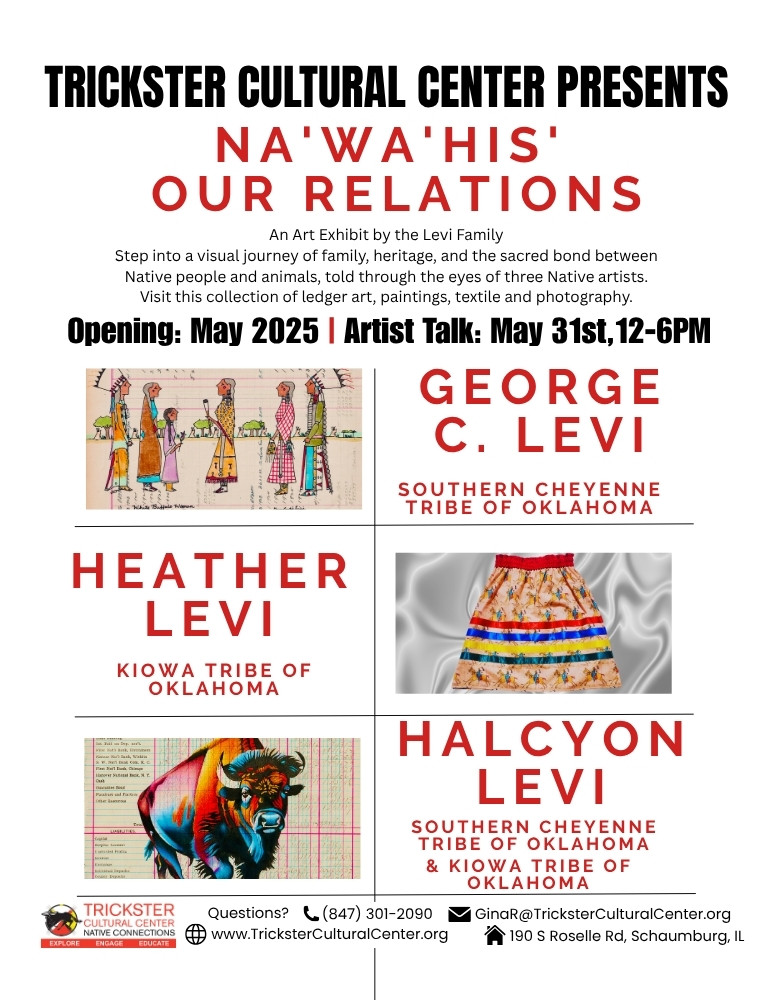
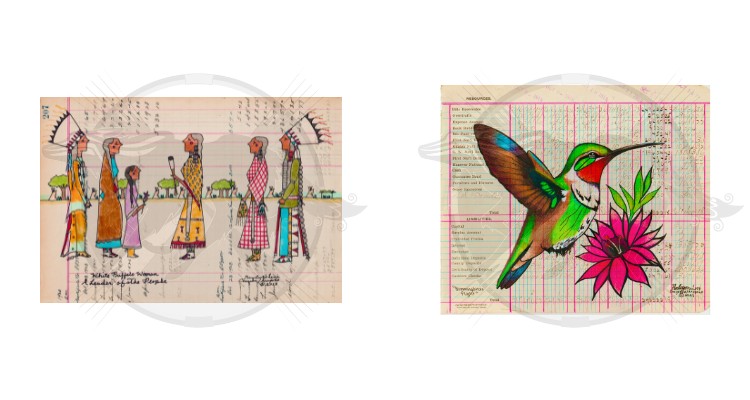
Explore Dinè cultural with our loom, weaving textile and dye chart.
Robert Wapahi is a citizen of the Dakota tribe and grew up on the Santee Indian Reservation in Nebraska. Wapahi is Vietnam war veteran and, among his other talents, a gifted storyteller.
This new installment in our west gallery is dedicated to regional and national Native American cultures, which includes sections dedicated to the Sac and Fox, Meskwaki, Ojibwe, Potawatomi, Apsáalooke, and Puyallup tribes. The webinar of the exhibit opening is now available on Trickster's Vimeo page!
*Click and drag mouse over picture to see more of the space. Gallery contents are subject to change; current exhibits are listed below.
The first section of the exhibit highlights the relationship between Native peoples and agriculture, spanning from medicinally used plants of Illinois to the time-honored relationship with wild rice. Hands-on activities for people of all ages will soon be available in this exhibit space to help visitors create a relationship with traditional plants.
Every day, Mother Earth gives us gifts of air, water, shelter and food. Since humans are not capable of photosynthesis, our lives depend on other lives for sustenance, both plant and animal. To bring honor to each life taken for our own, we treat the living world as our kin.

This section of “A Place of Teaching” presents information on the Puyallup tribe of the Pacific Northwest. This includes the stories of the widely successful 2018 canoe journey, and the Elders’ house-posts. Artifacts from the Field Museum and contributions of cultural items still in use today by the Puyallup Tribe are accompanied by translations in their traditional language.
Tribal canoe journeys retrace the paths, practices, and protocols of tribal ancestors. Traditionally, individual families would canoe from one native homeland to the next, asking permission to enter homelands. The revival of this traditional method of transportation and cultural experience began in 1989.

The north wall in the exhibit examines the dwelling of Woodland Tribes, known as a Wagnogan or commonly as wigwam. It showcases a representation made by Trickster staff members. Many tribes from the Great Lakes to the Eastern Woodlands used the wigwam as their winter lodging.
Wigwam doorways faced the Eastern direction so the people could greet the new day. The morning sun also warmed the dwelling entrance and prevailing winds were kept at bay.

This section focuses on the Great Plains tribes, centered by an expertly made Apsáalooke (Crow) style tipi. Historically, the tipi has been used by Indigenous peoples of the Plains in the Great Plains and Canadian Prairies of North America.
Tipi design varied among the Plains peoples, a major difference being the number of primary poles used for the structural frame. An Apsáalooke tipi is rounder with a four pole foundation. Longer poles create an hourglass look. Traditionally, the Apsáalooke tipi was made of several hides of animals sewn together, but today the coverings are made from canvas.

The southwest section of the exhibit highlights Native commitments to the US military; a timeline assists by constructing the various efforts in battles across centuries. The diverse make-up of Code Talkers, honoring Native Veterans’ stories, and showcasing Trickster’s Eagle Staff are included in this section.
The Department of Defense recognizes that today’s military successes depend heavily on Native Americans: 31,000 American Indian and Alaska Native men and women are on active duty today, serving in Iraq, Afghanistan, and elsewhere around the world. Native Americans served in the post-9/11 period in a higher percentage than veterans of other ethnicities, 18.6 percent vs 14 percent, respectively.

Trickster Cultural Center has made it a duty to acknowledge the traditional homelands we occupy. A map of the State of Illinois detail these cultures on the land that Tribal Nations have inhabited since time immemorial. We also use this space to thank everyone involved in the creation and implementation of the exhibit, including our sponsors.

The southeastern section exhibits our collaboration with the NHL’s Chicago Blackhawks, describing the history behind the team’s name and showcasing the “Veterans On Ice” program that honors both Natives and non-Natives alike who have served in the US military. Citizens of the Meskwaki and Sac and Fox Nation expand on the diverse lineal connections to Black Hawk.

Trickster Cultural Center seeks to increase the visibility of contemporary cultural arts with loaned pieces from the Field Museum in Chicago, Illinois. One of the latest artifacts is by Tu-ukumah (Blackhorse) from the Numunuu (Commanche Nation).

This main and featured gallery space is used to host national artists, world music concerts, and also provides amazing space for professional development training and other special events meeting our mission and values.
*Click and drag mouse over picture to see more of the space. Gallery contents are subject to change; current exhibits are listed below.
Trees of My Life is a deeply personal exploration of growth, memory, and transformation. Each tree in this collection represents a chapter of Jaqui Almaguer's journey—family, identity, love, loss, and transformation.
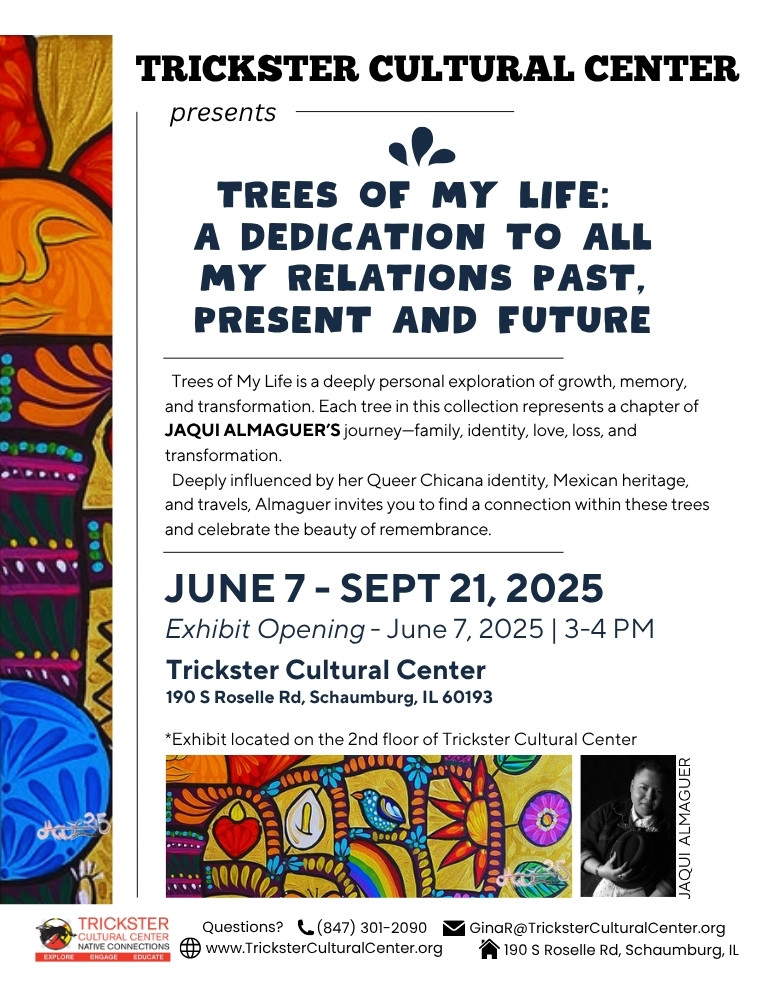

Trickster Media Campers (ages 8+) dove into photography, filmmaking, and brought their creative visions to life. Visit this young storytellers exhibit!
“100 Years of Healing” – Ojibwe Jingle Dress is an exhibit that celebrates the history of the jingle dress, its origins, and its healing power. This exhibit was on display at Trickster from October 2019 through February 2020. You can see pictures from the powwow celebrating this exhibit's closing in our Flickr album.
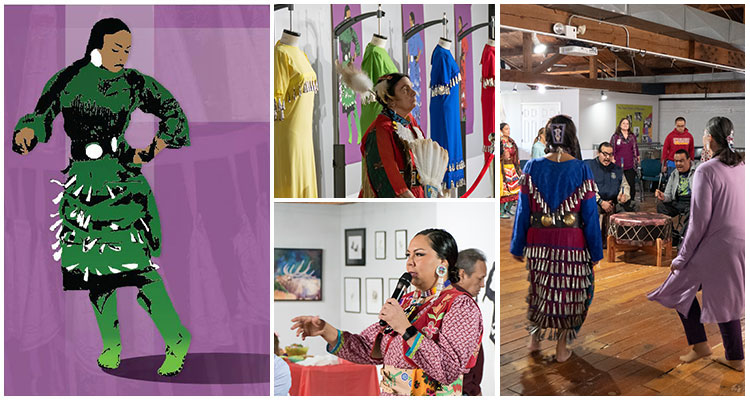
Experience the outdoor public art currently around the Trickster Cultural Center.
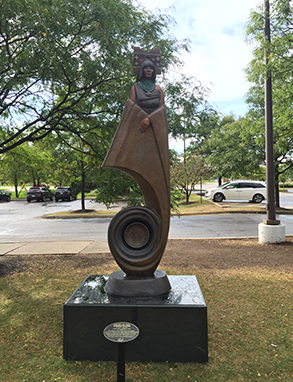
This statue is by Cliff Fragua. “Most indigenous cultures in the Americas have developed skills in the art of basketry. This sculpture honors the skills and people who developed that art. The star motifs represented on the tablita, or headpiece, are symbols from many different cultures representing their connection to the universe. The sculpture was cast in silicon bronze using the time-honored lost wax process."
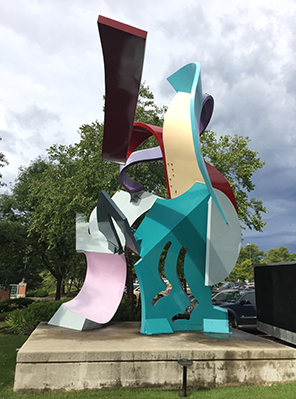
"Splash" is among the most vibrant of the many cultural landmarks populating Schaumburg. The monumental polychrome steel sculpture was created by Chicago native Jerry Peart, whose colorful sculptures can be found in many prominent Chicago area locations.
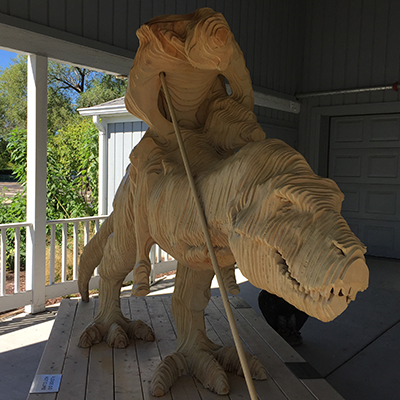
This statue, residing currently on the porch of Trickster Cultural Center, is by artist Lawrence Santiago.